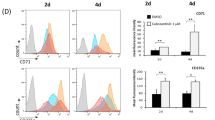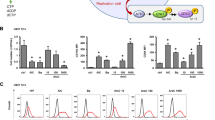Abstract
Human leukemogens, including alkylating chemotherapeutic agents and benzene, enhance granulocyte–macrophage colony-stimulating factor (GM-CSF)-dependent proliferation of human CD34+ bone marrow (BM) cells. The extracellular signal-regulated kinase (ERK) pathway plays an important role in GM-CSF-dependent proliferation and also has been implicated in the pathogenesis of acute myelogenous leukemia. Therefore, we investigated the effects of the benzene metabolite, hydroquinone (HQ), on alterations in the GM-CSF signaling pathway in TF-1 erythroleukemia cells and human CD34+ BM cells. HQ treatment in TF-1 cells results in a strong proliferative response that is dependent on ERK activation and GM-CSF production. HQ also induces ERK-dependent AP-1 activation with concomitant increased transcriptional activity of AP-1 reporter gene. However, the kinetics of ERK activation are different between rhGM-CSF and HQ in TF-1 cells: rhGM-CSF results in immediate activation of ERK, whereas HQ activation of ERK is delayed. Further, HQ and rhGM-CSF together produce an immediate increase in ERK phosphorylation, which is sustained for over 48 h. HQ also stimulates colony formation, AP-1 DNA binding and GM-CSF production in human CD34+ BM cells. These results suggest that HQ stimulates proliferation via activation of ERK/AP-1 and is at least partially mediated via the production of GM-CSF.
This is a preview of subscription content, access via your institution
Access options
Subscribe to this journal
Receive 12 print issues and online access
$259.00 per year
only $21.58 per issue
Buy this article
- Purchase on Springer Link
- Instant access to full article PDF
Prices may be subject to local taxes which are calculated during checkout







Similar content being viewed by others
References
Sandoval C, Pui C-H, Bowman LC, Heaton D, Hurwitz CA, Raimondi SC et al. Secondary acute myeloid leukemia in children previously treated with alkylating agents, intercalating topoisomerase II inhibitors, and irradiation. J Clin Oncol 1993; 11: 1039–1045.
Casciato DA, Scott JL . Acute leukemia following prolonged cytotoxic agent therapy. Medicine 1979; 58: 32–47.
Foucar K, McKenna RW, Bloomfield CD, Bowers TK, Brunning RD . Therapy-related leukemia. Cancer 1979; 43: 1285–1296.
Irons RD, Stillman WS . Cell proliferation and differentiation in chemical leukemogenesis. Stem Cells 1993; 11: 235–242.
Irons RD, Stillman WS, Colagiovanni DB, Henry VA . Synergistic action of the benzene metabolite hydroquinone on myelopoietic stimulating activity of granulocyte/macrophage colony-stimulating factor in vitro. Proc Natl Acad Sci USA 1992; 89: 3691–3695.
Irons RD . Effects of the benzene metabolite, hydroquinone, on regulation of differentiation and proliferation of human hematopoietic stem and progenitor cells in vitro. Toxicologist 1997; 36: 105–106.
Irons RD, Stillman WS . Impact of benzene metabolites on differentiation of bone marrow progenitor cells. Environ Health Perspect 1996; 104 (Suppl 6): 1247–1250.
Irons RD, Stillman WS . The effects of benzene and other leukaemogenic agents on haematopoietic stem and progenitor cell differentiation. Eur J Haematol 1996; 57 (Suppl 60): 119–124.
De Groot RP, Coffer PJ, Koenderman L . Regulation of proliferation, differentiation and survival by the IL-3/IL-5/GM-CSF receptor family. Cell Signal 1998; 10: 619–628.
Wheadon H, Roberts PJ, Watts MJ, Linch DC . Changes in signal transduction downstream from the granulocyte–macrophage colony-stimulating factor receptor during differentiation of primary hemopoietic cells. Exp Hematol 1999; 27: 1077–1086.
Wisdom R . AP-1: one switch for many signals. Exp Cell 1999; 253: 180–185.
Platanias LC . Map kinase signaling pathways and hematologic malignancies. Blood 2003; 101: 4667–4679.
Esnault S, Malter JS . Extracellular signal-regulated kinase mediates granulocyte–macrophage colony-stimulating factor mesenger RNA stabilization in tumor necrosis factor-α plus fibronectin-activated peripheral blood eosinophils. Blood 2002; 99: 4048–4052.
Kim SC, Hahn JS, Min YH, Yoo NC, Ko YW, Lee WJ . Constitutive activation of extracellular signal-regulated kinase in human acute leukemias: combined role of activation of MEK, hyperexpression of extracellular signal-regulated kinase, and downregulation of a phosphatase, PAC1. Blood 1999; 93: 3893–3899.
Kitamura T, Tange T, Terasawa T, Chiba S, Kuwaki T, Miyagawa K et al. Establishment and characterization of a unique human cell line that proliferates dependently on GM-CSF, IL-3, or erythropoietin. J Cell Physiol 1989; 140: 323–334.
McCubrey JA, Steelman LS, Hoyle PE, Blalock WL, Weinstein-Oppenheimer C, Franklin RA et al. Differential abilities of activated Raf oncoproteins to abrogate cytokine dependency, prevent apoptosis and induce autocrine growth factor synthesis in human hematopoietic cells. Leukemia 1998; 12: 1903–1929.
Kolonics A, Apati A, Janossy J, Brozik A, Gati R, Schaefer A et al. Activation of Raf/ERK1/2 MAP kinase pathway is involved in GM-CSF-induced proliferation and survival but not in erythropoietin-induced differentiation of TF-1 cells. Cell Signal 2001; 13: 743–754.
Kerzic PJ, Pyatt DW, Zheng JH, Gross SA, Le A, Irons RD . Inhibition of NF-kappaB by hydroquinone sensitizes human bone marrow progenitor cells to TNF-alpha-induced apoptosis. Toxicology 2003; 187: 127–137.
Pyatt DW, Zheng JH, Stillman WS, Irons RD . Inorganic lead activates NF-kappaB in primary human CD4+ T lymphocytes. Biochem Biophys Res Commun 1996; 227: 380–385.
Payne DM, Rossomando AJ, Martino P, Erickson AK, Her JH, Shabanowitz J et al. Identification of the regulatory phosphorylation sites in pp42/mitogen-activated protein kinase (MAP kinase). EMBO J 1991; 10: 885–892.
Alessi DR, Cuenda A, Cohen P, Dudley DT, Saltiel AR . PD 098059 is a specific inhibitor of the activation of mitogen-activated protein kinase kinase in vitro and in vivo. J Biol Chem 1995; 270: 27489–27494.
Karin M . The regulation of AP-1 activity by mitogen-activated protein kinases. J Biol Chem 1995; 270: 16483–16486.
Kinoshita T, Yokota T, Arai K, Miyajima A . Suppression of apoptotic death in hematopoietic cells by signalling through the IL-3/GM-CSF receptors. EMBO J 1995; 14: 266–275.
Metcalf D . The granulocyte–macrophage colony-stimulating factors. Science 1985; 229: 16–22.
Willman CL, Whittaker MH . The molecular biology of acute myeloid leukemia. Proto-oncogene expression and function in normal and neoplastic myeloid cells. Clin Lab Med 1990; 10: 769–796.
Haase D, Fonatsch C . Karyotype and in vitro-response to GM-CSF. Blut 1990; 60: 192–197.
Quentmeier H, Dirks WG, Fleckenstein D, Zaborski M, Drexler HG . Tumor necrosis factor-alpha-induced proliferation requires synthesis of granulocyte-macrophage colony-stimulating factor. Exp Hematol 2000; 28: 1008–1015.
Finlay GA, Thannickal VJ, Fanburg BL, Paulson KE . Transforming growth factor-beta 1-induced activation of the ERK pathway/activator protein-1 in human lung fibroblasts requires the autocrine induction of basic fibroblast growth factor. J Biol Chem 2000; 275 (36): 27650–27656.
Acknowledgements
We gratefully acknowledge Dr Vasilis Vasiliou for the generous gift of the 4AP-1 reporter gene, Wayne Stillman, Yanzhu Yang, Karen Helm for technical assistance and Ann Louden for the manuscript preparation. We also thank Dr Yanli Ouyang and Dr Ronda Baker for their constructive comments.
Author information
Authors and Affiliations
Corresponding author
Additional information
This project was supported by NIH Grant ES06258 to Dr Richard D Irons.
Rights and permissions
About this article
Cite this article
Zheng, J., Pyatt, D., Gross, S. et al. Hydroquinone modulates the GM-CSF signaling pathway in TF-1 cells. Leukemia 18, 1296–1304 (2004). https://doi.org/10.1038/sj.leu.2403389
Received:
Accepted:
Published:
Issue Date:
DOI: https://doi.org/10.1038/sj.leu.2403389



